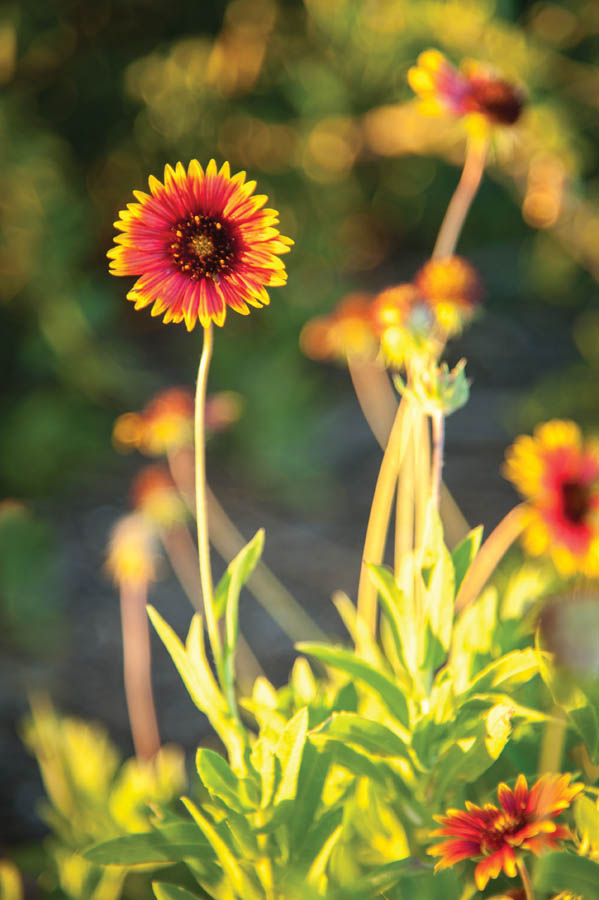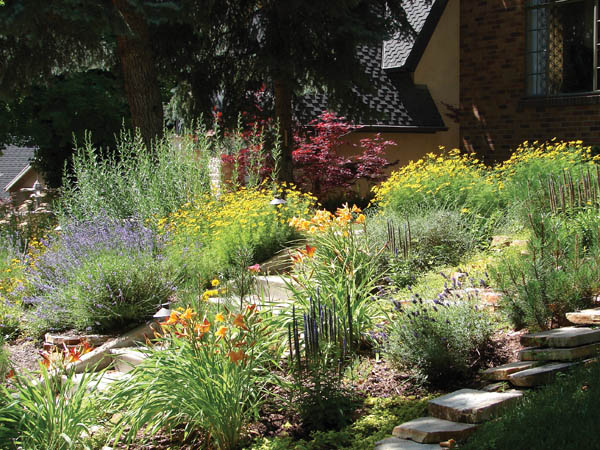Xeriscape landscaping is popular throughout the South and West as a means to protect precious water in areas that are arid and semi-arid. But did you know Denver Water coined the term? In 1981, the public utility combined “landscape” and the Greek word “xeros,” which means dry, as a means of promoting the use of plants in landscaping that are native to the area or those that are able to easily adapt to the local climate. In addition to being great for saving our local resources, a xeriscaped yard can also save you a precious resource: time that you can spend enjoying all the outdoor activities our great state has to offer. So, if you’d like to ditch the water-hogging, high-maintenance lawn for a more natural—albeit not necessarily neat and trim—landscape, we have some expert tips to transform your yard.



Planning 101
You’ve got to start with a plan to ensure you take into consideration all aspects of the property to properly implement the water-saving techniques. Things like existing trees, the driveway, sidewalks, plants or shrubs you want to keep, sloped areas, decks or patios and the perimeter of your home will matter in the planning. In addition, the direction your home faces matters, and so does the way you want to use the spaces in your yard. Do you need a place for the kids to play? The pups to run? Or a variety of seating areas for entertaining?
Getting Dirty
Soil on the Front Range is basically clay or sand—clay being dense and slow to absorb and release water, and sand … well, it doesn’t hold water. The great thing about using native plants is that they can grow well in both types of soil. You just need to know which soil your yard has in order to choose the right native plants.
Efficient Hydration
Your plants are going to need some water. Great planning can ensure you’re only giving them what they need and not a drop more. Installing an irrigation system designed for the specific types of plants with a timer control will minimize water waste. Be sure to water early in the morning or late in the evening and install a rain sensor to ensure the system shuts off if it’s raining. According to Denver Water, drip, spray or bubbler emitters are most efficient for watering trees, shrubs, flowers and groundcovers, while low-pressure, low-angle sprinklers are best for grass.
Plants and Zones
Colorado Natural Heritage Program identifies more than 3,000 Colorado-native grasses, plants, shrubs and trees, so there’s plenty to choose from when planning your plants. There are annuals and perennials in a mix of shapes and sizes, plants with lots of color and plants that are just great filler. As you’re choosing your favorites, it’s important to assess your yard—it will receive different amounts of light, wind and moisture in different areas. Group plants with similar light and water requirements and be sure to plant those that require more water in the low-lying areas of the yard or near downspouts. Put plants that require less water on higher ground. Use mulch to keep plant roots cool and minimize water evaporation.
Cut the Grass
What to do about that water-guzzling bluegrass turf? First, if you want to retain the cut-lawn look, you might need to accept the fact that you’re going to have a dormant, brown lawn for many months, and plant native species like buffalograss or blue grama that grow best in warm months. Other alternatives are cool-season species such as such as western wheatgrass, streambank wheatgrass or prairie junegrass, according to a native lawn fact sheet from Colorado State University’s department of horticulture and landscape architecture.
Take Care
Maintenance and care for a new xeriscaped yard is similar to a traditional landscape. You’ll need to water and weed and possibly prune some shrubs, but the work will decrease over time as the plants take hold. All that’s left to do is enjoy your new yard knowing you’re doing good for the planet and our natural resources, while you’re gaining back some much-needed relaxing—or playing—time for yourself.

Feed the Bees
Colorado has 946 species of native bees—that’s just bees, not even including other pollinators such as moths, butterflies, wasps and more. And these hungry little critters need to feed and in turn, spread pollen to maintain the health of flowering-plant species. Here are some fabulous plant choices to keep the pollinators buzzing about your yard from spring through fall. For more ideas, check extension.colostate.edu. Check the growing specifications to ensure you choose plants for your specific yard conditions.
Early-Season
Nodding onion (Allium cernuum)
Winecups (Callirhoe involucrate)
Prairie smoke (Geum triflorum)
Blue Flax (Linum lewisii)
Mid-Season
Lead Plant (Amorpha canescens)
Pearly everlasting (Anaphalis margaritacea)
Blanket flower (Gaillardia aristate)
Late-Season
Blue Giant Hyssop (Agastache foeniculum)
Rocky Mountain bee plant (Cleome serrulate)
Plains Coreopsis (Coreopsis tinctoria)
Rabbitbrush (Chrysothamnus nauseosus)
Boulder raspberry (Rubus deliciosus)
